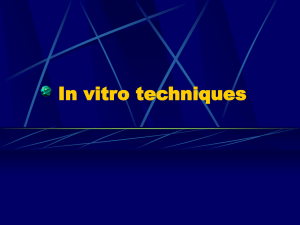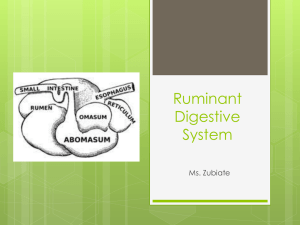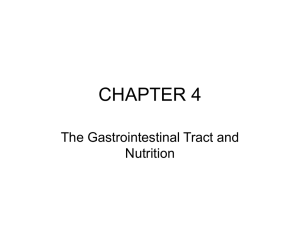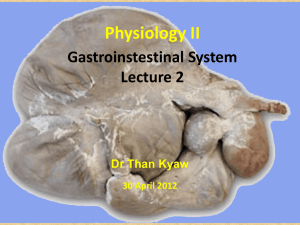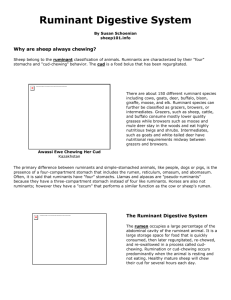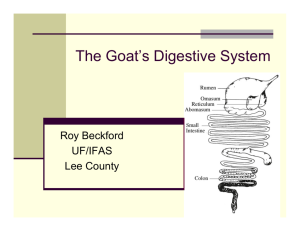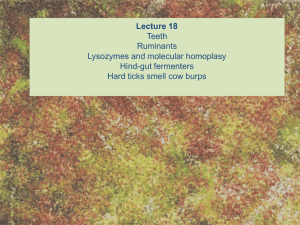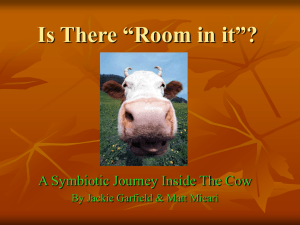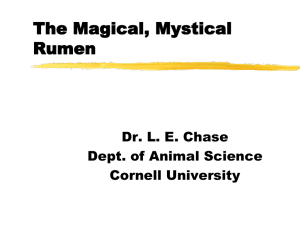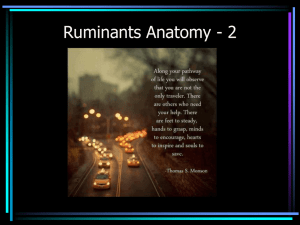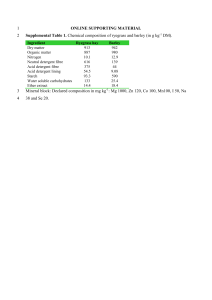Digestion - Faculty Web Sites
advertisement
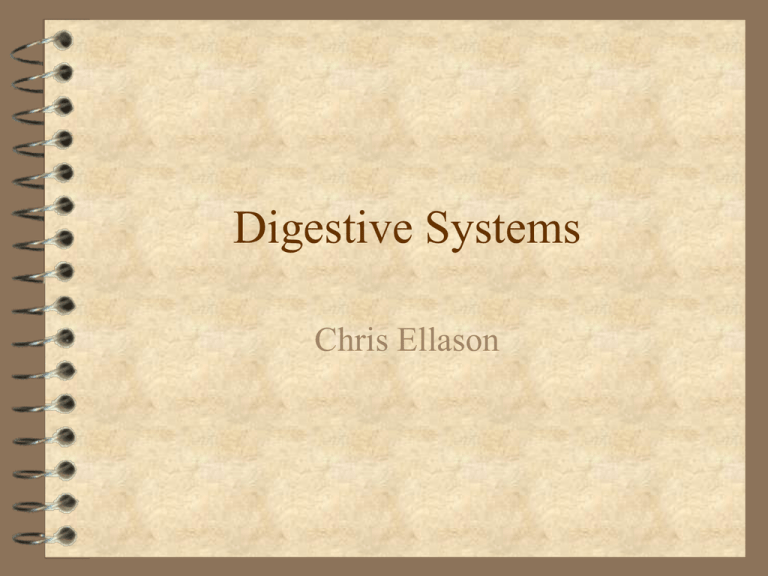
Digestive Systems Chris Ellason Digestion and Absorption: The process of digestion includes: – The prehension of food or feed – The mechanical chewing and grinding – Mixing with digestive acids and enzymes to chemically break down feedstuffs The process of absorption includes: – Transport of the digested foods across the intestinal mucosa to the blood or lymph system General Terms Prehension: to take into the mouth Mastication: chewing Deglutition: swallowing Regurgitation: the backward flow of food through the esophagus Three Major Categories Carnivore: consume flesh of other animals, examples are dogs and cats Omnivore: consume both plants and flesh, examples are primates Herbivore: consume plant material, examples are horses and cattle Carnivore Very Well developed stomach Uncomplicated intestine Limited fiber digestion Omnivore Combination of carnivores/herbivores More complicated GIT than carnivores Colonic digesters – Pigs, humans Cecal digesters – rat Herbivore Cow, horse, rabbit – Each has a different type of GIT Cow- ruminant Horse- simple stomach, large cecum, large sacculated LI Rabbit- larger stomach, very large sacculated cecum, unsacculated LI Salivary Glands 3 pair – Parotid – Mandibular – Sublingual Water - moistens food aids in swallowing Mucin - lubrication for swallowing Bicarbonate salts Enzymes Salivary Glands Salivary glands Different Digestive Tracts Farm animals have a variety of digestive systems – Ruminants: have 4 different compartments to the stomach • Examples include cattle, sheep, goats – Nonruminants (also known as monogastrics) • Hogs, dogs, and cats have a single, simple stomach • Poultry have a two part stomach • Horses have a large, functional cecum Pregastric vs Postgastric Pregastric: Fermentation that occurs in the rumen of ruminant animals. It occurs before food passes into the portion of the digestive tract in which digestion actually occurs. Postgastric: The fermentation of feed occurs in the cecum, behind the area where digestion has occurred. Pregastric vs Postgastric Ruminants – More efficient – Less intake Non- ruminant herbivores – Only postgastric – Less efficient – Greater intake Monogastric Systems Mouth: prehension and chewing of food; some carbohydrate enzyme activity Esophagus Stomach – Storage – Muscular movements (break down food) – Secretes Digestive Juices (hydrochloric acid) • pH about 2 Monogastric Systems Small Intestine Duodenum – Active Digestion Site – Produce enzymes • Pancreas – Helps to neutralize ingesta entering the SI • Liver – Produces bile; breaks down fats • Intestinal Walls Small Intestine Jejunum – Active in nutrient absorption Ileum – Active in nutrient absorption Villi pH 6 to 7 Large Intestine 3 Sections – cecum – colon – rectum Active in water resorption Secretion of some minerals *Bacterial Fermentation* Horses are Different Saliva – contains no enzymes – may secrete up to 10 gallons/day – stimulated by scratching Esophagus – only one way peristaltic movement • Impossible for regurgitation Horses are Different Stomach – much smaller in comparison to other species – not very extensive muscular contraction – So how should we feed differently? Small Intestine – same as pig but no gall bladder • Can’t handle a high fat diet Horses are Different Large Intestine – over 60% of GIT – 4 parts • • • • cecum large colon small colon rectum Cecum and Large Colon Similar to Rumen – bacterial cellulose breakdown – bacterial protein breakdown – VFA production – Water Soluble Vitamin production Small Colon and Rectum Primary site for water resorption Can become impacted with feed Horse GI Tract Avian Species Beak – no teeth – can be used to reduce particle size Esophagus – ingesta holding and moistening – Salivary Amylase – Fermentation in some species Avian Species Proventriculus – Gastric juice production – pH 4 – Rapid pass through of food Avian Species Gizzard (ventriculus) – thick muscular wall – particle size reduction (similar to mastication) – nonglandular – normally contains grit – no enzymatic secretion Avian Small Intestine Functions in digestion and absorption of feed and nutrients just as in other monogastrics pH is slightly acidic Most enzymes found in mammals except? Avian Large Intestine Contains 2 blind pouches instead of ? Mostly water absorption Some bacterial activity but less than in most mammals very short in comparison Avian Species Ruminant Digestive System Mouth – what is unique about the teeth? – Can only chew on one side of mouth at a time Saliva production is continuous Production about 12 gallons/d Rumen Stomach 4 PARTS – reticulum – rumen – omasum – abomasum Reticulum Honeycomb most cranial not truly separated from rumen no enzymatic secretion walls are tough, tend to catch heavy objects Rumen Large compartment extends from diaphragm to pelvis papillae Fermentation chamber Majority of absorption of byproducts and conversion to volatile fatty acids Rumen Digestion Reticulorumen provides a favorable environment for bacterial fermentation Continuous turnover of digesta and removal of fermented digesta Anaerobic fermentation Omasum Manyplies (Stockmans Bible) short blunt papillae very muscular no enzymatic secretion reduction of particle size water resorption Abomasum True Stomach First Glandular portion of the tract Very similar in structure and function to nonruminant stomach Other Unique Points Esophageal Groove – cardia to omasum – milk bypass Rumination: The process where rumen contents are regurgitated, remasticated, and reswallowed for further digestion Eructation: expulsion of accumulated fermentation gases from rumen via esophagus Ruminant GI Tract Rumination Regurgitation of ingesta with mastication – reticular contraction that concentrates ingesta at the cardia – increased inhalation of air at same time – contraction of diaphragm – ballooning of esophageal walls – ingesta sucked into esophagus – returned to mouth by reverse peristalsis Rumination Excess liquids are swallowed Mastication commences More time spent masticating here than initial intake Amount of time ruminating is a function of diet composition Rumen Contents and Motility Rumen contents are not uniform Occur in stratified layers Change from ventral to dorsal Rumen mat – high concentrate diets eliminate mat – more viscous fluid in high grain diets – lowest dry matter in high forage diets Rumen Contents and Motility Motility of rumen mixes contents Divided into – primary contractions – secondary contractions Contractions require up to 50 seconds to complete Rumen Contents and Motility Contractions begin with reticulum Progress dorsally Finish with ventral blind sac and ventral pillars Rumen and Acute Acidosis Optimal rumen pH is 6.7 Variation in pH is normally +/- 0.5 Introduction of high grains result in – breakdown of rumen mat – proliferation of facultative anaerobes – these produce high levels of lactic acid Rumen and Acute Acidosis Lactate is a much stronger acid that other VFAs In severe cases lactate can make-up well over 50% of total rumen acids Succinate and Formate can also appear in high quantities Rumen and Acute Acidosis Increased acids can reduce pH as far as 4.0 Severe rumenitis occurs at these pH levels Absorption of lactic acid results in systemic acidosis All chronic acidosis results in rumen parakeratosis Factors Affecting Digestibility Rate of passage: increased rate of passage of digesta through the tract reduces digestibility – Factors increasing rate of passage include: • Increased level of feeding/intake (ruminants) • Finer processing (such as grinding) of feed Note: grinding grain usually increases digestibility but grinding hay decreases digestibility

